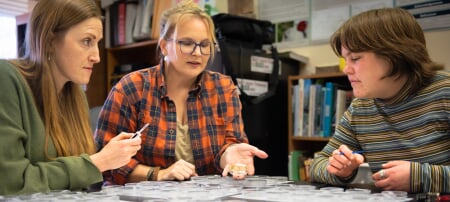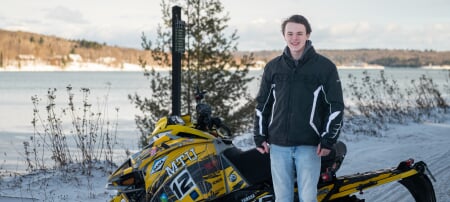Kettering, McGill Win 2014 Clean Snowmobile Challenge

Kettering University has finally caught the bouquet. After two years as runner up in the internal combustion division, the Flint-based team took the gold the 2014 SAE Clean Snowmobile Challenge.
“We’re ecstatic,” said team leader Matt Birt. “This is our first win at Michigan Tech, and we couldn’t be happier.”
Kettering also received other honors: the PCB Group Award for the Quietest Snowmobile; the BlueRibbon Coalition Award for the Most Practical Solution, which balances cost with noise and emissions reduction; and the Emitec Award for Best Value, which incorporates cost, fuel economy and performance. In addition, Kettering will take home the new MacLean-Fogg Cup, a traveling trophy sculpted and cast in bronze by Michigan artist Sergio DeGiusti.
The State University of New York at Buffalo finished the Challenge’s internal combustion division in second place, with the University of Idaho taking third.
The results highlight the students’ mastery of a variety of technologies. Kettering
won with a four-stroke gasoline engine. Buffalo excelled with a diesel-powered sled,
while Idaho used a two-stroke gasoline sled. “It’s as if the judges said, ‘I can’t
decide, so I’ll have one of each, please,” said lead organizer Jay Meldrum.
Michigan Technological University, which hosts the event, experienced the snowiest
winter in years with temperatures solidly sub-freezing, ideal conditions for this
Society of Automotive Engineers collegiate design competition. In the Clean Snowmobile
Challenge, engineering students in the internal combustion category take a stock snowmobile
and reengineer it. Their aim: to reduce emissions and noise and increase fuel efficiency
while preserving the riding excitement demanded by snowmobile enthusiasts.
The Challenge also includes a zero emissions category sponsored by the National Science Foundation, which relies on electric snowmobiles to conduct atmospheric research in pristine arctic locations.
Kettering triumphed over a fiercely competitive field. In a contest traditionally marked by breakdowns and uncertain beta-version technologies, the sleds this year were remarkably reliable. On the second day of the Challenge, nine of the 10 snowmobiles starting the 100-mile Endurance Run made it to finish line. In previous years, this event was almost guaranteed to winnow out half the entrants.
The story was different in the zero emissions division. Only one of the four teams to field a sled was able to pass inspection and get out on the snow. “The rules are getting harder,” said Ali Najmabadi, a member of McGill University’s winning team. “There’s more emphasis on safety, and we’re happy to have put a sled together that was safe enough for the judges.”
South Dakota School of Mines and Technology took second in the division, with Queen’s University finishing in third place.
Najmabadi, who captained his team to a first-place finish in 2013, attributed McGill’s success to a take-it-slow, incremental strategy. “We don’t like to change every year,” he said. This year, they focused on fine-tuning their sled for each aspect of the competition. McGill also received the SAE Award for Best Design in the zero emissions category and the Talon Research Safety Award.
Kettering relied on a simple, light Skidoo sled armed with a turbocharged Miller cycle powertrain and a Rotax 600 ACE engine. “And we achieved low noise in our economy mode through an electronic throttle,” said Birt.
Advances like these are critical to the future of snowmobiling, said Art Jeffers, acting forest supervisor of the Huron-Manistee National Forest, who represented the US Forest Service at the Challenge. “Snowmobile emissions and noise reduction are central to the free enjoyment of public lands and to minimizing user conflict,” he said. “The snowmobiling industry and the clubs have made great strides, and with their sponsorship, the Challenge has been a great way to move the technology forward.”
Dan Hancock, the president of SAE, recognized the value of the Challenge to the team members, noting that it hones skills that are sought after by employers. “Industry knows the value of people who’ve been through these experiences,” he said.
Meldrum reflected on the 2014 Challenge after Saturday’s award ceremony. “The internal combustion teams were more competitive than ever,” he said. “There were problems with the zero emissions sleds, but they will get better as they address the higher safety standards.”
Next year, the Challenge will dedicate a separate category to diesel-powered sleds, Meldrum said. That’s an acknowledgment of both their maturing design and their niche use, which differs from gasoline-powered snowmobiles.
Diesel sleds are ideal for hauling and long-distance riding because of their power and superior fuel economy. “Even the National Science Foundation is thinking of using them,” Meldrum said. “And John Deere, Cummins, Terex and Caterpillar have all told me we should have a separate category to help educate engineering students in diesel technology.”
Sleds in the next year’s Challenge will continue to use a biofuel mix based on gasoline and isobutanol. Isobutanol is distilled from corn, like ethanol, but it blends better with gasoline and has more energy. The entries will need to adapt to a “mystery blend,” a fuel recipe that contains an unknown percentage of isobutanol.
Several other universities earned special awards during the Challenge.
The University of Idaho was honored with the SAE International award for Best Design, Polaris Industries Award for Best Handling, the Camoplast Award for Best Performance and the DENSO Award for Best Ride.
SUNY Buffalo captured the Sensors Inc. Award for Lowest In-Service Emissions and the AVL Award for Best Emissions with its biodiesel-powered snowmobile.
The University of Wisconsin-Platteville earned the International Engineering and Manufacturing (Woody’s) Award for Best Acceleration, achieving speeds of 73 mph; and the HB Performance Systems Award, for its implementation of the HB Trail Trac system.
North Dakota State University earned the Gage Products Award for Best Fuel Economy by achieving 28.68 mpg with its diesel-powered snowmobile.
The University of Wisconsin-Madison received the Mahl Powertrain Award for best engine design.
Queen’s University was honored with the Michigan Tech Keweenaw Alumni and Friends Chapter Award for its static display presentation.
The University of Minnesota Duluth earned the BASF Corporation Award for Innovation for its efforts to reduce track friction.
The University of Waterloo received the Aristo Intelligent Catalyst Technology Award for Most Improved Snowmobile.
Michigan Tech received the Bill Paddleford Founder’s Award for Most Sportsmanlike Conduct.
Teams receiving the NGK Spark Plugs/NTK Sensors Cold Start Award were the University of Wisconsin-Madison, University of Wisconsin–Platteville, the University of Idaho, Michigan Tech, SUNY-Buffalo, North Dakota State and Kettering.
The Clean Snowmobile Challenge is sponsored at Michigan Tech by the Keweenaw Research Center and the Department of Mechanical Engineering–Engineering Mechanics.
Michigan Technological University is an R1 public research university founded in 1885 in Houghton, and is home to nearly 7,500 students from more than 60 countries around the world. Consistently ranked among the best universities in the country for return on investment, Michigan's flagship technological university offers more than 185 undergraduate and graduate degree programs in science and technology, engineering, computing, forestry, business, health professions, humanities, mathematics, social sciences, and the arts. The rural campus is situated just miles from Lake Superior in Michigan's Upper Peninsula, offering year-round opportunities for outdoor adventure.




Comments